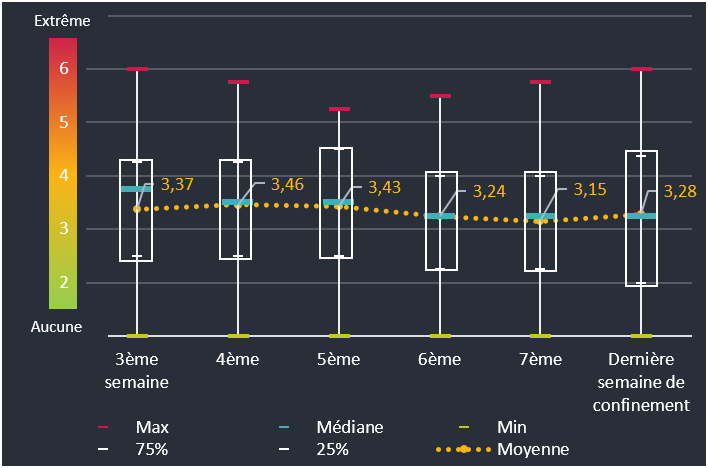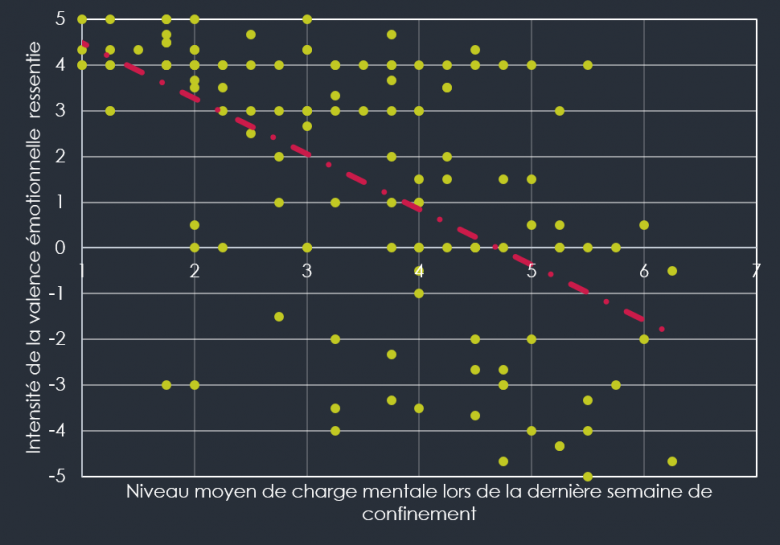- Decisions and knowledge
- Home and Business Experiences
- Human and social sciences
- Sustainable digital society
What were the effects of this long interlude? How did workers find bringing their professional and personal lives together? What lessons have we learned, and what can we recommend for remote working in the future?
This unprecedented situation provided an opportunity for us to study, over a six-week period, the effects of remote working during lockdown on the mental load and emotional state of 67 Orange employees in France. New avenues were explored in terms of both thinking and action to guide the future of remote working.
"The employees showed their ability to adapt to the situation, particularly due to their capacity to make up for anything lacking and to establish routines."
An underdeveloped way of working
Remote working first appeared in France in the 1970s. Studies conducted before the period of large-scale remote working during the first lockdown (March 17 to May 11, 2020) had already revealed both benefits and drawbacks.
Remote working is “an activity in which employees make intensive use of information technology for work outside of their company’s premises.” Coutrot 2004[1]
Some writers, including Khanna & New in 2008 and Martin & MacDonnell in 2012 (cited by Vayre)[2], as well as the study conducted by Bordonné [3], conclude that remote working aids concentration, productivity, efficiency and work quality, particularly in the case of thinking tasks. It also allows employees to feel more independent, as they can manage and organize their tasks and activities more freely. The absence of a commute to the workplace gives employees extra time to work or do other things. Remote workers feel more present with the people around them and more flexible in terms of time, and suffer less from the demands of family life.[2,3]
But it’s not all plain sailing. Several writers cited in Vayre’s review of the literature2 claim that remote working increases workloads, exposes employees to physical risks (musculoskeletal problems) and psychosocial issues and exacerbates stress. According to some employees, it therefore increases job dissatisfaction and feelings of loneliness, isolation and exclusion at work.
Galvez and colleagues[4] have counterbalanced this picture, specifying that, to have a positive effect for employees, remote working must be clearly defined (working hours and conditions) and viable for everyone wishing to do it. All employees must be provided with the technological infrastructure needed to work from home and be given financial support for the expenses associated with it. Managers must focus on supporting remote working by establishing a relationship of trust and respect with their colleagues. If these conditions are not met, situations of conflict and work stress encourage remote workers to overwork, which can knock their work-life balance off kilter. [5]
To sum up, remote working is beneficial for some activities that are well-defined in advance, and when alternated with working on site. However, this practice has not caught on in France and is limited to the privileged few.
“Let’s end these preconceptions about remote working! We have to look at things differently.” Martine Bordonné, 2012 (Director of Remote Working at Orange France)
An experience imposed on the majority of employees
On Tuesday, March 17, 2020, a strict national lockdown was imposed to limit the spread of the COVID-19 virus. A large number of employees had to work from home for almost two consecutive months. Everybody tried this new way of working, even the least enthusiastic.
While the pandemic undoubtedly increased anxiety among the public, lockdown was seen as a positive measure that would protect the health of the general population[6].
After two weeks of lockdown, the summary proposed by Abad6 showed that 61% of respondents found it “easy to work from home.” This mandatory measure changed employees’ and managers’ views on remote working.
Between March 27 and May 11, 2020, an exploratory study was conducted as part of a psychology thesis involving an assessment of mental load and emotional state (Sophia Antipolis) to explore the effects of lockdown on the employees of an Orange entity in France.
(Mental) workload is one consequence of employees’ intense efforts to meet the demands of the task, in certain material conditions and according to their frame of mind (which varies from person to person depending on a range of intrinsic characteristics, and which changes over time) and the various mechanisms involved in the work. Tort 1976 – Theureau 2002[7]
A longitudinal exploratory study of 67 Orange employees
This study was conducted at Orange as part of a research program looking at the impact of digital tools on customer relations activities in order to analyze the effect of working in lockdown on employees’ mental load. The factors influencing mental load were identified and monitored as the weeks passed. Employees’ feelings and spontaneous remarks were also recorded.
Over 100 employees received an online questionnaire each week. Of these, 67 (34 women and 33 men) responded regularly. Most of the voluntary participants were middle managers working in research and development. They were located throughout France, and 64% of them were in lockdown with one or more children. The majority (81%) had access to a private outside space (e.g. a balcony, patio or garden) during lockdown.
Although 97% of the employees had already worked from home before this measure was imposed, nearly 50% said that remote working during lockdown required more effort than working at the office. However, 67% said that they had enjoyed or really enjoyed this particular period.
It seems, then, that well-being and effort are two distinct things and must both be taken into account in studies of quality of life at work.
In fact, workload and the effort put in by the employee are not necessarily reflective of the employee’s level of well-being — and that, in turn, cannot indicate their mental load. A heavy mental load is not synonymous with discontent, while a light mental load does not necessarily mean that the employee is feeling good.
As part of the study, the employees estimated their level of effort each week—according to the following six factors—on a 7-point Likert scale ranging from “No effort” to “Extreme effort.”
- employee activity
- use of digital equipment
- environment
- remote interaction with colleagues and manager
- lack of visual contact
- emotions (last questionnaire)
These responses made it possible to calculate each employee’s mental load each week so that changes could be monitored.

Average mental load changed for all 67 employees during lockdown
The average and median mental load levels remained “stable” throughout the lockdown. We can see that the gap between employees with a light mental load and those with a heavy mental load widened in the last week of lockdown.
There appear to be two types of perceptions and behaviors expressed, depending on the individuals involved and the time in their lives.
- The first is individuals for whom remote working during lockdown was not a major problem (light mental load). Sophie Marinopoulos, a psychologist and psychoanalyst, explains that, for some people, during this period, “not much changed in their lives. […] It was almost ‘well timed’: as if the obligation to slow down, stay at home and focus on themselves and their families was a blessing.” [8](p14)
- The second is those for whom remote working in lockdown was more complicated. Time began to drag and the negative aspects outweighed any positives (heavy mental load). Indeed, “for some, it represented fear and a form of regression in their personal lives, with descriptions of panic, feelings of abandonment and a very heightened sense of loneliness,” explains Marinopoulos.[8](p14)
Of the six factors studied (listed above), work, the absence of direct contact, and emotions had a strong effect on the effort made by employees to carry out their activities in these specific conditions.
However, the use of digital tools (instant messaging, videoconferencing, etc.) required little effort from the user. It should be noted that the employees who responded to the questionnaire said that they were familiar with or expert users of these digital tools. It is therefore not surprising that using these tools did not present any major difficulties. As such, their implementation was partly or even completely automated for these employees, who could then focus their attention on other aspects requiring more effort (e.g. a work task or managing their feelings).
Feelings were generally aroused by events whose consequences related to the individual’s concerns.
Although we often talk about “emotional states,” they are very rarely stable. In fact, emotional processes are constantly changing to enable us to quickly adapt to different circumstances and situations.
Some writers[9,10] study emotions in terms of their intensity and their valence. Emotional valence refers to the attractiveness or averseness of an event.

Correlation between employees’ emotional intensity and mental load
Deeper statistical analyses were conducted on the link between “emotional intensity” and “mental load.” A significant negative correlation was found between the intensity of employees’ positive or negative emotions and their mental load.
In other words, the stronger their negative feelings (guilt, disappointment, sadness, etc.), the heavier their mental load. Conversely, the stronger their positive feelings (interest, joy, pride, etc.), the lighter their mental load. The hypothesis proposed is that managing emotions, particularly negative ones, is key to reducing the effect they have on employees’ workloads. Robert Van de Weerd[10] reports that analysis of emotional load produces interesting information about how employees’ activity is managed. Taking it into account aids the interpretation of the entire dynamic of conducting an activity — regulation mechanisms, for example. This data paves the way for more in-depth research.
A general linear model was used to predict the relationship between mental load and the factors taken into account during the study (e.g. family situation, meeting frequency, frequency of use of digital tools, etc.). The model produced nine parameters, which explain 64% of the variation in mental load between the employees. Of these nine parameters, three have particularly marked effects.
- Anticipation of effort: if employees correctly anticipate the effort required to work from home efficiently, they will have a lighter mental load than those who underestimate it.
Having a clear view of objectives and the order of priority of tasks allows employees to effectively anticipate the effort required, thereby reducing the negative impact related to organization and task-planning on their mental load. - Frequency of informal interaction: employees used to informal interaction at work will have a heavier mental load during lockdown because they will find it harder to interact “quickly” remotely. In fact, interacting remotely requires more effort. We often talk about the “Zoom”[11] effect, because the brain is used to analyzing non-verbal signals to help us understand the people we are talking to. During remote conversations, these signals are no longer there, reducing the quantity of information available.
- Ease of use of digital tools: the more at ease employees feel using their digital tools, the less the negative impact on their mental load. Taking the time to find out about, learn and independently use the digital tools provided for work enables their use to become automatic, freeing up more attention resources for the task at hand.
The study also reveals the importance of team bonding and social connection with colleagues. The company and its productivity will benefit if employees get on well and enjoy working together. Analysis of the data resulting from this study shows the importance of social interaction in the variation of employees’ mental load. However, it is important to find a balance between maintaining social connection and the right to disconnect to enable better concentration without interruptions. It is therefore recommended to let employees choose whether to work remotely or not, while offering shared days at the office to facilitate group and company-wide activities as much as possible. In fact, direct interaction is necessary, since spontaneous conversations benefit employees’ productivity, development of ideas and well-being, helping them to come up with quick solutions to the problems they encounter, compare their ideas with those of others and not feel isolated or excluded. Throughout this period, the employees were aware of the shortcomings of remote interactions, with 63% mentioning this as a negative aspect of remote working.
Moreover, the individuals interacting with their working community on a daily basis were, in our study, part of a local company community: neighbors in the office, sporting activities, company canteen, etc. Occasions for informal conversations relating to these local communities are important social links that should be preserved, but they don’t exist outside of physical meetings within shared working environments, regardless of the type of activity involved.
In conclusion, what lessons were learned?
For more than two consecutive months, remote working was pushed to its limits by the lockdown. This specific context enabled us not only to observe how employees adjusted to this new way of working but also to analyze its positive and negative effects. While this period was very difficult for some employees, for the majority it revealed a new way of working for them to consider.
Sibony[12] explains that remote working lends itself to the completion of clearly defined individual tasks for the execution of existing projects, and does not prevent social links previously created within the company from being maintained. On the other hand, collective working, renewing social capital (meeting new people), creating activity and defining new projects, and changing roles within the company are activities described as “telefragile” — in other words, they may not be as successful when teleworking, or working from home. These findings are called into question in the context of remote working during lockdown, when even pre-existing social connections are weakened.
Generally speaking, guiding and supporting remote working, while clearly defining its rules and conditions, are the keys to making this way of working beneficial. Here, managers play a central supporting role, particularly in terms of regulating activity. For example, they can remind employees of the importance of downtime in order to limit over-investment, which can have a negative impact on work-life balance.
To go further, it would be interesting to study the effects of remote working on the mental load of employees in an area other than research and development. Aspects related to the nature of the tasks involved and the geographical distribution of the teams of employees appear to be interesting avenues for research.
Organization and anticipation of activities are one lever for better management of employees’ mental load. In fact, not everyone shared the same feelings about mixing their working and personal lives. It may have caused disorganization, with a lack of anticipation of the tasks added to day-to-day working activities.
According to Socrates, what makes us human is our great capacity for adjustment. Indeed, the employees showed their ability to adapt to the situation, particularly due to their capacity to make up for anything lacking and to establish routines. This resulted in a stable mental load over the weeks. Some also said that they were worried about going back to the office.
As remote working again was once again enforced in France as of October 30, 2020, the importance of monitoring mental load is clear.
Bibliography
- Coutrot T. Le télétravail en France: 2% de salariés le pratiquent à domicile, 5% de façon nomade. Published online 2004. http://www.epsilon.insee.fr/jspui/bitstream/1/3865/1/2004.12-51.3.pdf
- Vayre É. Les incidences du télétravail sur le travailleur dans les domaines professionnel, familial et social. Le travail humain. 2019;82(1):1-39.
- Bordonné M. Résultats de l’Enquête Télétravail 2018. Published online 2018:59.
- Gálvez A, Martínez MJ, Pérez C. Telework and work-life balance: some dimensions for organisational change. Workplace rights. 2012;16(3):273-297.
- Boboc A. Avec le télétravail, les salariés ne sont pas égaux dans la gestion de la frontière entre les sphères privées et professionnelles. ANACT. Published online 2020. Accessed June 15, 2020. https://www.anact.fr/avec-le-teletravail-les-salaries-ne-sont-pas-egaux-dans-la-gestion-de-la-frontiere-entre-les-spher-0
- Abad F. Synthèses, Les Français Face à La Crise Du Coronavirus.; 2020. Accessed August 25, 2020. https://plazza.orange.com/groups/connaissance-clients/blog/2020/04/16/les-fran%C3%A7ais-face-%C3%A0-la-crise-du-coronavirus
- Theureau J. La notion de “charge mentale” est-elle soluble dans l’analyse du travail, la conception ergonomique et la recherche neuro-physiologique ? Published online 2002.
- Guardiola I. Retour sur nos vies confinées. Valeurs Mutualistes. 2020;320(2).
- Simonazzi N, Salotti J-M, Dubois C, Séminel D. Détections des émotions sur un smartphone à partir des interactions des utilisateurs. Proposition de protocole expérimental. In: 54e Congrès International de La Société d’Ergonomie de Langue Française. ; 2019. Accessed December 13, 2020. https://hal.archives-ouvertes.fr/hal-02393182
- Ribert-Van De Weerdt C. Analyse des émotions en situation de travail, une approche psycho-ergonomique. In: Colloque ÉPIQUE, Nantes. ; 2001.
- deHahn P. Zoom fatigue is something the deaf community knows very well. Quartz. Published online 2020. Accessed August 7, 2020. https://qz.com/1855404/zoom-fatigue-is-something-the-deaf-community-knows-very-well/
- Sibony O. Télérobuste ou téléfragile : le télétravail peut détruire l’entreprise. Stratégie & Management. Published 2020. Accessed August 4, 2020. https://www.xerficanal.com/strategie-management/emission/Olivier-Sibony-Telerobuste-ou-telefragile-le-teletravail-peut-detruire-l-entreprise_3748650.html










